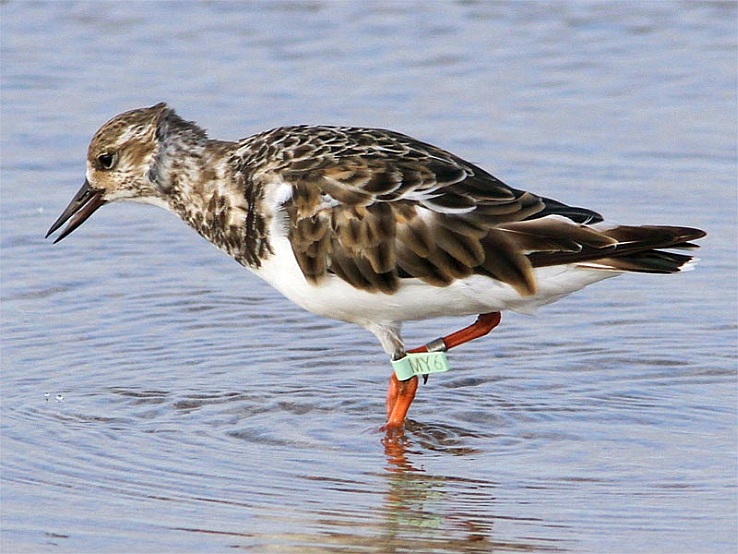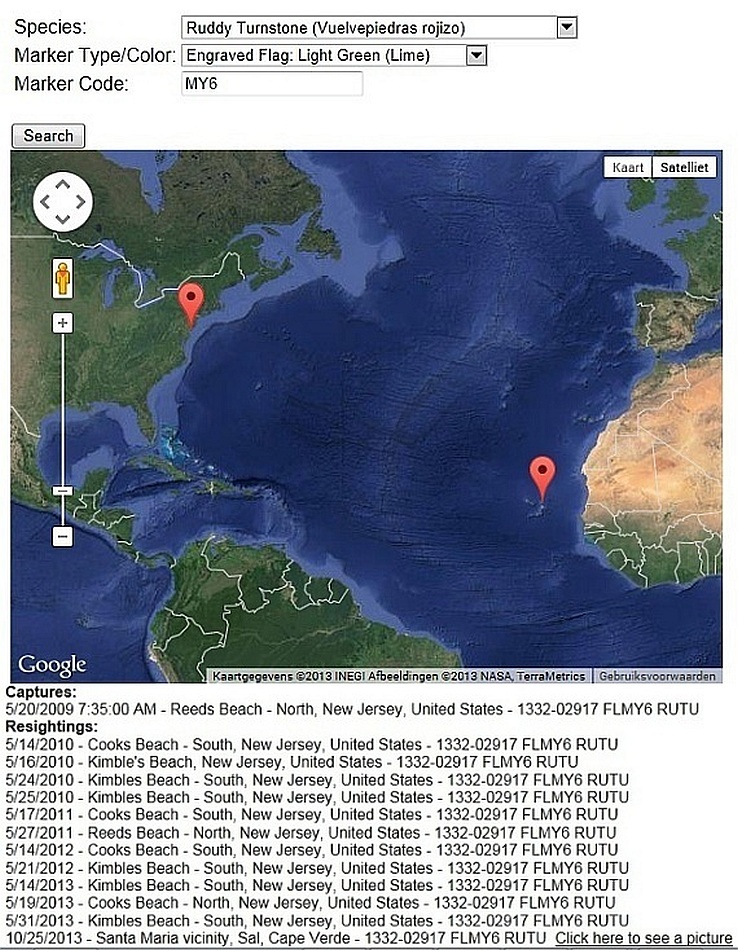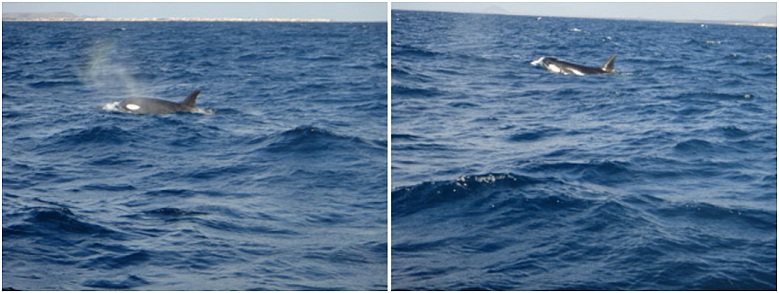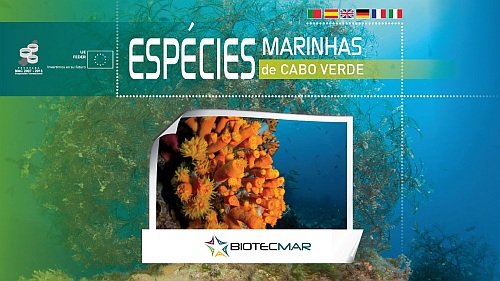SOCIEDADE
CABOVERDIANA DE
ZOOLOGIA
ZOOLOGICAL NEWS | NOTÍCIAS ZOOLÓGICAS
No. 4 - JANUARY | JANEIRO DE 2014

Newsletter of the | Boletim de Sociedade Caboverdiana de Zoologia
Editado por / Edited by Cornelis Hazevoet (cjhazevoet at gmail.com)
Have you seen, heard or read something of zoological interest? Let us know!
Viu, leu ou ouviu algo com interesse zoológico recentemente? Informe-nos!
The transatlantic flight of turnstone MY6

While observing waders at a pool near Santa Maria, Sal, 25 October 2013, Dutch birdwatchers Ellen de Bruin and Ricardo van Dijk discovered a turnstone Arenaria interpres wearing a metal ring as well as an engraved colour flag (Fig. 1). The flag could be easily read and subsequent inqury showed that the bird had been ringed and flagged at Reeds Beach, Delaware Bay, New Jersey, USA, on 20 May 2009. It was resighted in New Jersey each Spring during the years 2010-2013, the sighting in Cape Verde being the first in Autumn (Fig. 2). Turnstone is a Holarctic and circumpolar breeding bird, which winters along the coasts of Europe, Africa, southern Asia, Australia, southern North America and Central and South America. It essentially migrates south from the Arctic breeding grounds, but birds from Greenland and NE Canada are known to cross the Atlantic and winter in western Europe and NW Africa. It therefore seems likely that the bird at Santa Maria originated from breeding grounds in Greenland or NE Canada, demonstrating that turnstones seen in Cape Verde (where it is a common wintering migrant) do not necessarily stem from Eurasian breeding grounds.

Fig. 2. Map showing ringing and resighting locations of turnstone Arenaria interpres MY6 in New Jersey and the Cape Verde Islands and list of resightings of the same bird during the years 2010-2013.
Killer whales off Sal in November 2013
[SCVZ EDITOR’S NOTE: Killer whales are seldom reported from Cape Verde seas. Although perhaps more regular than the few reports suggest, there are only two confirmed recent observations, i.e. a pod of nine animals south of Santa Maria, Sal, 29 February 1996 (Hazevoet & Wenzel 2000, Contributions to Zoology 69: 197-211) and one off western Boa Vista, 21 September 2001 (Hazevoet et al. 2010, Zoologia Caboverdiana 1: 75-99).]

The osprey breeding season on Boa Vista in 2013
As in 2012, predation by the brown-necked raven Corvus ruficollis was the major cause of reproduction failure. At least six of the 10 active nests monitored this season lost their brood due to predation by brown-necked ravens. Humans were probably responsible for the failure of one nest, while the loss of another nest could be either due to predation by ravens, feral cats or humans.
No young ospreys successfully fledged from the 10 active nests in 2013. This is a serious cause of concern, taking into account the low productivity in 2012, the lack of breeding data in the period 2007-2012 and the low mean productivity in the period 2004-2007. Unless effective protection measures are implemented without delay, the extremely low breeding success of the Boa Vista osprey population during the past decade may jeopardize its long-term survival. This research was sponsored by Cabeólica S.A., wind energy producer in the Cape Verde Islands
Tropicbirds at Ponta do Roque, Boa Vista, in 2013

Table 1. Number of occupied nests of red-billed tropicbird Phaethon aethereus at Ponta do Roque, Boa Vista, during the 2012 and 2013 surveys. ? = not visited.
New book on marine fauna of Cape Verde

Zoological News from the Newspapers
Notícias Zoológicas de Jornais
Ninhos de Tartaruga Verde localizados pela primeira vez em Cabo Verde
A ONG SOS Tartarugas acredita ter encontrado, na ilha do
Sal, rastros e ninhos da tartaruga verde, uma espécie que se acreditava não
existir no nosso país. Nos seus seis anos de actividade apenas rastros e ninhos
da tartaruga Caretta caretta
(tartaruga cabeçuda) foram localizados no arquipélago. Mas este ano rastros
completamente diferentes apareceram na Costa Fragata e devem pertencer à
Tartaruga Verde. Há seis anos que a SOS Tartarugas recolhe dados e informação
sobre tartarugas desovantes em Cabo Verde, mas até à data apenas rastos de
tartaruga–cabeçuda (Caretta caretta) têm sido vistos. No entanto, este ano foi
localizada uma área do ninho muito maior do que o normal, o padrão e o tamanho
do rastro levaram a equipa a crer que se trata de um ninho de tartaruga verde Chelonia mydas.
As tartarugas verdes são maiores do que as cabeçudas, bem
como os seus ninhos e ovos. Segundo a ONG, o ninho corria risco de inundação,
por estar muito perto da linha de maré alta, pelo que os ovos foram transportados
para a incubadora. Esta situação também permitiu à SOS Tartarugas pesar e medir
os ovos, que tem em média cerca de 47 mm, enquanto os da tartaruga cabeçuda
possuem cerca de 41 mm. Também o número de ovos encontrado neste ninho (166)
foi superior comparativamente ao número médio de ovos por ninho de tartaruga cabeçuda
(80-120). “Este tem sido um ano extraordinário para as Tartarugas verdes, de
acordo com alguns relatórios, e esta expansão aparente do seu habitat pode ser
de grande interesse para os cientistas de todo o mundo, para além de consolidar
a importância de Cabo Verde como sítio de desova”, diz Berta Renom, da SOS
Tartarugas. O ninho deverá eclodir a 20 de Outubro.
Nascem
as primeiras tartaruguinhas-verdes no Sal
Já nasceram numa incubadora na ilha do Sal as primeiras
tartaruguinhas-verdes. São ao todo 72 animais que brotaram de um único ninho,
encontrado na praia de Costa Fragata, nos finais do mês passado. A libertação
ao mar aconteceu no final da tarde desta quarta-feira.
Os primeiros nascimentos aconteceram no último domingo no
viveiro da Praia de Ponta de Sinó, para onde foi transferido o ninho encontrado
na praia de Costa Fragata com 166 ovos. Até este momento já nasceram 72
tartaruguinhas na ilha do Sal. Mas a SOS Tartarugas acredita que ainda possa
haver alguma que não conseguiu sair à superfícies. As 72 tartaruguinhas foram
todas libertadas para o mar. Inicialmente a SOS Tartarugas queria fazer a
libertação-pública na praia de Santa Maria, perto do Pontão, mas não teve o
aval da Direcção Geral do Ambiente, diz Berta Renon, uma das biólogas desta
organização. O lançamento ao mar aconteceu em privado na Costa da Fragata.
Este não é o primeiro ninho de tartarugas-verdes
encontrado no país. Na Boa Vista também foi descoberto um ninho desta espécie,
durante este período de nidificação. Daí que a SOS Tartarugas, juntamente com a
Turtle Foundation, tem feito recolhas de amostras que serão enviadas a um
laboratório para ver se os dois ninhos pertencem a uma única tartaruga. “Pode
ser que os dois ninhos sejam da mesma mãe, ou não. Temos agora de esperar os
resultados laboratoriais para ver”, anuncia Berta Renon, explicando que esta
espécie está em aparente expansão de seu habitat e que pode ser de grande
interesse para os cientistas de todo o mundo, para além de consolidar a
importância de Cabo Verde como sítio de desova.
As tartarugas-verdes (Chelonia
mydas) são maiores que as de tartarugas-cabeçudas (Caretta caretta), bem como os seus ninhos e ovos. Esta espécie tem
bordas brancas nas barbatanas e a parte inferior do corpo é branca. As crias
pesam aproximadamente 15g.
Novo acordo de pescas em cima da mesa
O novo acordo de pescas que a União
Europeia quer assinar com Cabo Verde vai ter a duração de seis anos, diz um
relatório da Comissão Europeia publicado na semana passada em Bruxelas. Segundo
os autores do documento, o novo acordo de pescas a ser assinado, será
"mais satisfatório" graças à grande quantidade de peixe capturado em
águas nacionais. O acordo actual foi assinado em 2011 e termina em Agosto do
próximo ano e permite que 25 navios de pesca da União Europeia de pesca de atum
e 35 embarcações de pesca à linha operem em Cabo Verde. Mas agora a União
Europeia quer assinar um novo acordo de pescas com Cabo Verde. Um acordo mais
duradouro e que permitirá aos navios pesqueiros europeus continuarem as suas
operações de pescas em águas nacionais por mais seis anos. O início das
negociações está marcado para breve.
Praga de
gafanhotos ameaça agricultura na Boa Vista
Uma praga de gafanhotos está a dizimar hectares de
culturas do Norte da ilha da Boa Vista. Os agricultores de João Galego têm-se
desenrascado como podem, mas a delegação do Ministério do Desenvolvimento Rural
(MDR) garante que está no terreno a combater a praga.
Tudo indicava que ia ser um bom ano agrícola, pois choveu
em boa quantidade na Boa Vista. Mas há cerca de um mês que uma forte praga de
gafanhotos começou a invadir as culturas no Norte, a veia agrícola da ilha. “Está
a ser um problema porque os gafanhotos estão a comer de tudo. O MDR disse-nos
que já não têm o remédio para matar os gafanhotos. E agora o agricultor que
tiver um pouco de remédio vai colocando no auto-dinamizador para pulverizar os
cultivos”, diz o agricultor Danilo Cruz.
Entretanto, o MDR garante que está a lutar contra à praga de gafanhotos. O delegado, Osvaldo Viera, diz que os técnicos estão no terreno. “Neste momento temos técnicos no centro piloto em João Galego, as máquinas estão alocadas no terreno, temos produtos, damos indicações com assistência técnica e eles mesmos fazem os tratamentos”, assegura, alertando os agricultores para que tenham muito cuidado na venda dos seus produtos, empestados de insecticidas. Para além deste combate, Osvaldo Vieira assegura que o MDR tem levado a cabo uma forte campanha para controlar a reprodução de gafanhotos e prevenir a proliferação para as áreas agrícolas. “A Boa Vista é a ilha que tem maior índice de ataques de gafanhotos desde a primeira invasão. A estratégia da campanha começa desde o litoral onde foi detectado maior desova de gafanhoto do deserto que se afectar a zona agrícola o prejuízo poderá ser ainda maior. Estivemos dois meses a trabalhar no local e foram gastos um milhão de contos em todo esse processo”, afiança.
A Semana, 22 Novembro de 2013
Recent papers on Cape Verde Zoology and Paleontology
Artigos recentes
sobre Zoologia e Paleontologia Caboverdiana
ABSTRACT Blubber lipid concentrations of 14 organochlorine compounds
and 10 polychlorinated biphenyls (PCB) were measured by gas
chromatography with electron-capture detection in eastern North
Atlantic humpback whales Megaptera novaeangliae
from Cape Verde (n = 20) and Ireland (n = 4). Concentrations were
statistically compared to those from 20 samples collected from the Gulf
of Maine in the western North Atlantic. Pollutant burdens were compared
using males only, in order to circumvent biases associated with
reproductive offloading. Lipid-normalised PCB concentrations were below
the estimated threshold toxicity value of 17 000 ng g−1 for blubber in
marine mammals. Dichlorodiphenyltrichloroethane (DDT), PCB and
chlordane concentrations were an order of magnitude lower than those
previously reported for Gulf of Maine humpback whales and higher than
those reported from the North Pacific Ocean. Higher concentrations of
lower-chlorinated PCB congeners (28, 31 and 52), hexachlorocyclohexanes
and hexachlorobenzene in males in eastern North Atlantic sites is
consistent with higher latitude feeding grounds. Lower p,p’-DDE
(dichloro-diphenyldichloroethane):ΣDDT ratios suggest that whales from
the eastern North Atlantic harbour more recent inputs of DDT. The
ΣDDTs:ΣPCBs ratio was higher for males from Cape Verde (1.69) and
Ireland (1.44), indicating proportionately greater sources of
agricultural rather than industrial sources of pollutants than for the
Gulf of Maine whales (0.75). We demonstrate potential for persistent
organochlorine pollutants (POPs) as tracers to determine foraging
ground provenance for samples collected on breeding grounds in the
North Atlantic. Low concentrations suggest that POPs are unlikely to be
a factor in the poor recovery rate of humpback whales in Cape Verde.
Potential adverse effects of inorganic pollutants on clinical parameters of loggerhead sea turtles (Caretta caretta): Results from a nesting colony from Cape Verde, West Africa. M. Camacho, J. Orós, L.D. Boada, A. Zaccaroni, M. Silvi, C. Formigaro, P. López, M. Zumbado & O.P. Luzardo, 2013. Marine Environmental Research 92: 15-22. http://dx.doi.org/10.1016/j.marenvres.2013.08.002
ABSTRACT A large number of nesting loggerhead sea turtles (n =
201) were sampled to establish the blood levels of 11 elements (Cu, Mn,
Pb, Zn, Cd, Ni, Cr, As, Al, Hg, and Se). Almost all of the samples
showed detectable levels of these 11 elements, and Zn and Se exhibited
the highest concentrations (median values as high as 6.05 and 2.28
μg/g, respectively). The median concentrations of the most toxic
compounds, As, Cd, Pb, and Hg, were relatively low (0.38, 0.24, 0.06,
and 0.03 μg/g, respectively). We also determined the haematological and
biochemical parameters in a subsample of 50 turtles to evaluate the
potential effects of these contaminants on clinical parameters and
found several associations. Our study reinforces the usefulness of
blood for the monitoring of the levels of contaminating elements and
their adverse effects on blood parameters in sea turtles.
Interviews with fishers suggest European longlining threatens sea turtle populations in Cape Verdean waters. José Melo & Tommy Melo, 2013. Marine Turtle Newsletter 138: 18-19.
[No abstract – Marine Turtle Newsletter 138 can be downloaded here.]
Assessment of oil contamination in the bay of Porto Grande (Cape Verde) using the mullet Chelon bispinosus. N. Pinheiro, L. Barreira, B. Lopes & M.J. Bebiano, 2013. African Journal of Environmental Science and Technology 7 (7): 657-670; http://dx.doi.org/ 10.5897/AJEST2013. 1432
ABSTRACT Polycyclic aromatic hydrocarbons (PAHs) are a group of
persistent organic pollutants, some of which are mutagenic and
carcinogenic, so PAH concentrations in fish used for human consumption
are crucial to assess impact on human health. Total PAH concentrations
in muscle and liver of mullets Chelon bispinosus
from the Bay of Porto Grande (Cape Verde) (four sites in the bay and a
control) ranged from 112.7 to 779.5 and 291.5 to 7548.7 ng/g d. w.,
respectively. Two and three ring PAHs were the most frequent (72.8 to
90.8% in the muscle and 75.9 to 98.3% in the liver), but levels of
carcinogenic PAHs (mainly Dibenzo (a,h) antracene) in certain sites (CN
and PG) are of concern. Results reflect a chronic PAH pollution in the
bay and sources are a mixture of anthropogenic (petrogenic and
pyrolytic) and natural sources, making their identification extremely
complex. Although, BaP levels were below the threshold established by
Cape Verde and the European Union, BaPEs levels in muscle ranged from
0.28 to 3.66 ng/g w. w. and BAPEs and TPAHs exposure for the average
adult was 0.02 to 0.26 and 1.6 to 11.2 μg/day, respectively. Further
knowledge of PAH concentrations in other species is necessary for a
proper environmental risk assessment policy.
The occurrence of Sparisoma frondosum (Teleostei: Labridae) in the Cape Verde Archipelago, with a summary of expatriated Brazilian endemic reef fishes. Rui Freitas, Osmar J. Luiz, Pericles N. Silva, Sergio R. Floeter, Giacomo Bernardi & Carlos E. L. Ferreira, 2013 (early online). Marine Biodiversity PDF
http://dx.doi.org/10.1007/s12526-013-0194-z
ABSTRACT The occurrence of the Brazilian endemic parrotfish Sparisoma frondosum
is confirmed for the Cape Verde Archipelago, in the Tropical Eastern
Atlantic. In total, 12 species of reef fishes previously thought to be
either endemic or originated in the Brazilian Province have been
recently recorded as vagrants in the southern Caribbean and in West
African offshore islands. We suggest that the seasonal and somewhat
overlooked North Equatorial Counter-current should receive more
attention as a potential dispersal route for marine organisms crossing
the Atlantic in a west-east direction.
A revision of Artemia biodiversity in Macaronesia. Francisco Hontoria, Stela Redón, Marta Maccari, Immaculada Varó, Juan Carlos Navarro, Luís Ballell & Francisco Amat, 2012. Aquatic Biosystems 8 (25), 7 pp.; http://dx.doi.org/10.1186/2046-9063-8-25
ABSTRACT In a biogeographical context, the term Macaronesia
broadly embraces the North Atlantic archipelagos of the Azores,
Madeira, Selvagens, the Canary Islands, and Cape Verde. The peculiar
arid climatic conditions in some of these places have led to the
development of marine salt exploitations, which can be counted among
the hypersaline habitats of the brine shrimp Artemia
(Branchiopoda, Anostraca). Parthenogenetic populations of this
anostracan were described in the Canary Islands during the last decades
of the 20th century, while the American Artemia franciscana
species was recently found in the Cape Verde archipelago. Following an
invasive pattern, this exotic species has recently reached the Canary
Islands, too. This paper reports information dealing with biotope loss
(solar saltworks) in this biogeographical region, together with
possible consequences concerning the arrival of invasive species, two
factors that frequently promote dramatic biodiversity losses. The
discussion of this threat focuses mainly on the Canary Islands
archipelago where native species of Artemia still exist.
The apid cuckoo bees of the Cape Verde Islands (Hymenoptera, Apidae). Jakub Straka & Michael S. Engel, 2012. ZooKeys 218: 77-109; http://dx.doi.org/10.3897/zookeys.218.3683
ABSTRACT The apid cuckoo bees of the Cape Verde Islands (Republic of
Cape Verde) are reviewed and five species recognized, representing two
genera. The ammobatine genus Chiasmognathus Engel (Nomadinae: Ammobatini), a specialized lineage of cleptoparasites of nomioidine bees is recorded for the first time. Chiasmognathus batelkai sp. n. is distinguished from mainland African and Asian species. The genus Thyreus Panzer (Apinae: Melectini) is represented by four species – Thyreus denolii sp. n., T. batelkai sp. n., T. schwarzi sp. n., and T. aistleitneri sp. n. Previous records of Thyreus scutellaris (Fabricius) from the islands were based on misidentifications.
Faunistic notes on Arctiid moths of the Cape Verde Islands with description of a new species (Lepidoptera: Erebidae, Arctiinae). E. Aistleitner & K. Černý, 2013. Linzer biologische Beiträge 45 (1): 297-306.
ABSTRACT Notes on distribution and phenology of Arctid moths from
the Cape Verde-Islands are given. A new species is described as Eilema aistleitneri nov.sp. by K. Černý from ilha do Sal.
Flora und Vegetation des kaboverdianischen Archipels – ein kleiner Überblick. Eyjolf Aistleitner, 2013. Sauteria 20: 207-221.
ABSTRACT This article presents the flora and vegetation of Cape
Verde. The introduction shows topography, geology and climate to
understand the biotic situation. A brief consideration concerns the
settlement through plant and animal organisms, together with two tables
and original photos.
[SCVZ EDITOR’S NOTE: As the title implies, this paper primarily deals
with the flora of Cape Verde, but there is also a section on fauna.]
Ichnology in oceanic islands; case studies from the Cape Verde Archipelago. E. Mayoral, J. Ledesma-Vazquez, B.G. Baarli, A. Santos, R. Ramalho, M. Cachão, C.M. da Silva & M.E. Johnson, 2013. Palaeogeography, Palaeoclimatology, Palaeoecology 381-382: 47-66.
http://dx.doi.org/10.1016/j.palaeo.2013.04.014
ABSTRACT Miocene and Pleistocene marine deposits in the Cape
Verde Archipelago are represented by a series of thin, transgressive
sandy-bioclastic limestones that typically occur between subaerial
and/or submarine volcanic flows. This position within volcanic flows
makes them an ideal paleobathymetric case study, because the
submarine/subaerial passage zone above them provides a reliable and
independent indicator of paleodepth. In terms of paleoichnology, the
older Miocene sediments are characterized by the Thalassinoides ichnoassociation, whereas, Pleistocene sediments are characterized by the Macaronichnus–Dactyloidites ichnoassociation. The fair-weather suite of the proximal Cruziana ichnosubfacies is represented by the ichnotaxa Dactyloidites, Bichordites, Cardioichnus, Phycodes, Teichichnus, aff. Taenidium, Palaeophycus and Thalassinoides in addition to the Thalassinoides ichnoassociation. The Macaronichnus–Dactyloidites ichnoassociation is more complex, including representatives of both the proximal Cruziana and Skolithos ichnofacies. Only representatives of the Skolithos ichnofacies (Skolithos, Macaronichnus, Conichnus
and Ophiomorpha) are represented in the post-storm suite. So far,
bioerosive structures were found on the Miocene/Pleistocene
unconformity surface of Maio Island and on basaltic paleocliffs at
Ponta das Bicudas on Santiago Island. They are represented by the
ichnoassemblage Gastrochaenolites torpedo–Entobia isp., corresponding to the Entobia
ichnofacies. Bathy-metric calibration deduced from the position of the
following passage zone between submarine and sub-aerial lava flow
allows for confirmation of the proximal Cruziana ichnosubfacies and Skolithos ichnofacies at a paleodepth between 12 and 18 m depth.
